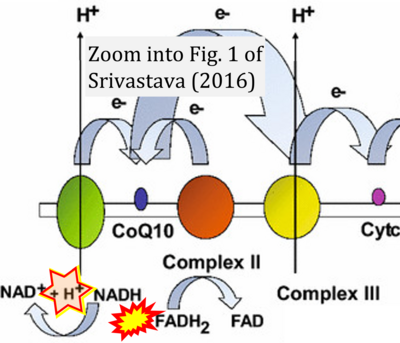Srivastava 2016 Clin Transl Med
| Srivastava S (2016) Emerging therapeutic roles for NAD(+) metabolism in mitochondrial and age-related disorders. Clin Transl Med 5:25. https://doi.org/10.1186/s40169-016-0104-7 |
Srivastava S (2016) Clin Transl Med
Abstract: Nicotinamide adenine dinucleotide (NAD(+)) is a central metabolic cofactor in eukaryotic cells that plays a critical role in regulating cellular metabolism and energy homeostasis. NAD(+) in its reduced form (i.e. NADH) serves as the primary electron donor in mitochondrial respiratory chain, which involves adenosine triphosphate production by oxidative phosphorylation. The NAD(+)/NADH ratio also regulates the activity of various metabolic pathway enzymes such as those involved in glycolysis, Kreb's cycle, and fatty acid oxidation. Intracellular NAD(+) is synthesized de novo from L-tryptophan, although its main source of synthesis is through salvage pathways from dietary niacin as precursors. NAD(+) is utilized by various proteins including sirtuins, poly ADP-ribose polymerases (PARPs) and cyclic ADP-ribose synthases. The NAD(+) pool is thus set by a critical balance between NAD(+) biosynthetic and NAD(+) consuming pathways. Raising cellular NAD(+) content by inducing its biosynthesis or inhibiting the activity of PARP and cADP-ribose synthases via genetic or pharmacological means lead to sirtuins activation. Sirtuins modulate distinct metabolic, energetic and stress response pathways, and through their activation, NAD(+) directly links the cellular redox state with signaling and transcriptional events. NAD(+) levels decline with mitochondrial dysfunction and reduced NAD(+)/NADH ratio is implicated in mitochondrial disorders, various age-related pathologies as well as during aging. Here, I will provide an overview of the current knowledge on NAD(+) metabolism including its biosynthesis, utilization, compartmentalization and role in the regulation of metabolic homoeostasis. I will further discuss how augmenting intracellular NAD(+) content increases oxidative metabolism to prevent bioenergetic and functional decline in multiple models of mitochondrial diseases and age-related disorders, and how this knowledge could be translated to the clinic for human relevance.
• Bioblast editor: Gnaiger E
Correction: FADH2 and Complex II
- FADH2 is shown as the substrate feeding electrons into Complex II (CII). This is wrong and requires correction - for details see Gnaiger (2024).
- Gnaiger E (2024) Complex II ambiguities ― FADH2 in the electron transfer system. J Biol Chem 300:105470. https://doi.org/10.1016/j.jbc.2023.105470 - »Bioblast link«
Labels:
Enzyme: Complex II;succinate dehydrogenase


